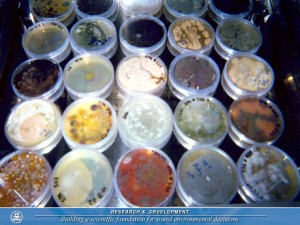So, you suspect that you have mold in your home… What do you do now? How do you find out for sure?
While it is true that mold may be a natural part of our environment — when a home is healthy, it won’t have mold problems. For some, figuring our where the mold is and where it is coming from will be easier than for others. When mold is hidden, you will have to hunt to find it. If there is or has been a leak in your home, then that is the first place to look.
- Check your in you attic to see if there has been any leaks in the roof.
- Check around any plumbing and pipes to see if there are any leaks.
- Are there water spots anywhere?
- Is there a black substance (or what looks like dirt) anywhere on your walls, in your carpet, or in your insulation?
- Does your basement feel or smell damp?
- Has your carpet or flooring gotten wet from flooding and it wasn’t replaced?
- Is there a musty or moldy odor anywhere?
- Are there any other water sources (for example, a fish tank) in your house that might be leaking? .
- Is food molding faster than normal? If so, mold may be already airborne in your house. Before I finally found visible mold in my house, I would no sooner buy something at the store and have turn moldy sitting out on my kitchen counters only days after buying it. At first, I thought the store was selling me old items.
- Is your clothes dryer not vented properly to the outside?
- Is mold forming inside your toilet tank? If there is a mold problem in your house, any place having moisture might start growing mold too, even though you keep your house clean.
For mold to grow, it needs moisture (water) and a food source (wallboard, insulation, carpet, etc). And, it will keep growing until the moisture source is removed and the mold spores are completely removed (remediated). If mold is growing too long in an indoor environment, it produces mycotoxins and can become airborne (which is when it can really be dangerous to your health).
IMPORTANT! Use caution when looking for mold. If you open a closed area with mold (for instance, in your walls or even while demoing a kitchen) you could cause the mold to become airborne contaminating the rest of the house and your lungs/body. If you are doing it yourself, be sure to appropriately protect yourself.
To know what you are dealing with, you will likely want to do testing to see what species are present and how much is airborne.
Types of Molds

Source: US EPA. Mold growing in Petri dishes. (photo courtesy of Stephen Vesper, Ph.D.)
Just to give you some idea of which molds might indicate there has been an water issue in your home, the ERMI Carpet Sampling test looks for 36 different molds, and compares your results against the EPA database of moldy and healthy homes:
The following 36 mold species are associated with WATER-DAMAGED ENVIRONMENTS:
|
The following 10 species of molds are considered COMMON MYCOFLORA in homes:
|


